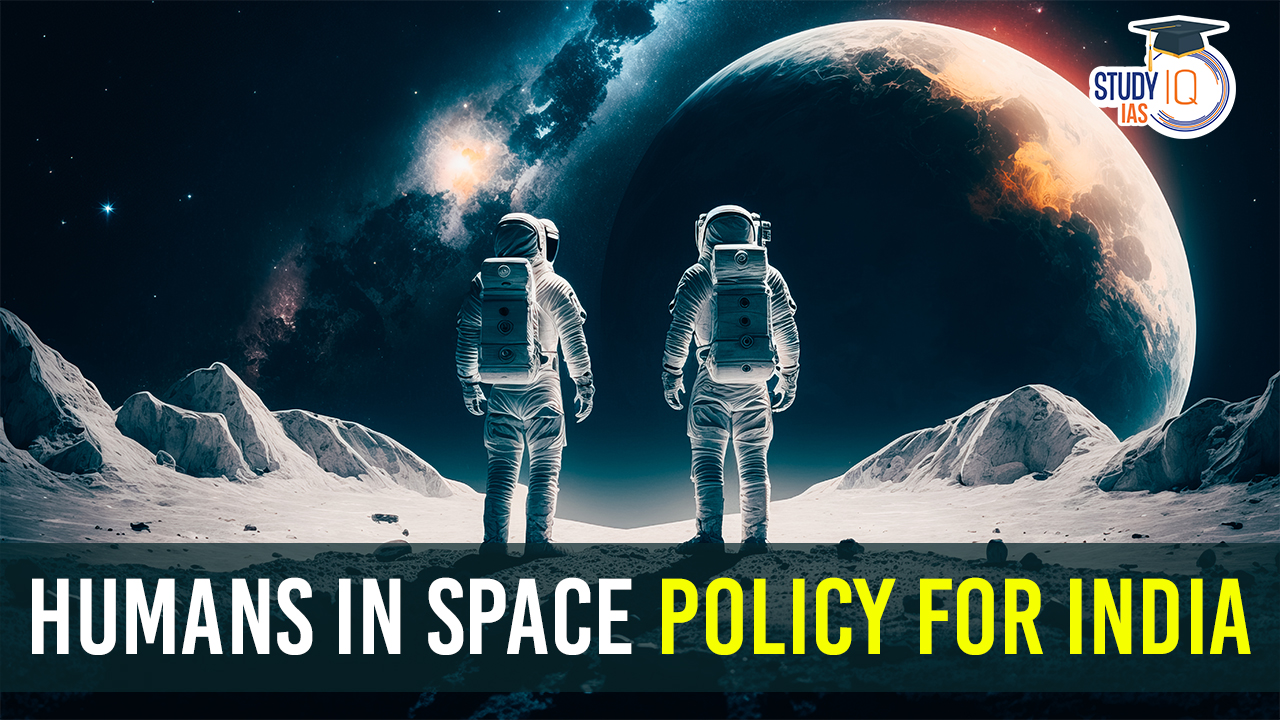Table of Contents
India’s longstanding plan for a human space mission (Gaganyaan) is a decade-long endeavor that, if successful, will place the country among the elite few with human presence in outer space. In pursuit of sustained human space exploration for socio-economic advancement, the Department of Space introduced the Draft Humans in Space Policy for India 2021.
Humans in Space Policy for India
“Human Space Policy 2021, policy, under government review, fosters local start-ups and industry involvement for technology development. ISRO’s two-member team focuses on mission technology research. Prepared by the Department of Space (DoS), it advocates international collaboration, offering opportunities to domestic players. Initial plans involve launching humans into low-Earth orbit (LEO), with a long-term vision of sustained presence in LEO and beyond. The policy embraces capacity-building, collaboration, infrastructure development, and technology promotion, underscoring India’s ambition to thrive in the realm of human space exploration.
We’re now on WhatsApp. Click to Join
Humans in Space Policy and Implementation
- Preamble Acknowledging Evolving Space Dynamics:
- The preamble of the Draft “Humans in Space Policy” recognizes the dynamic nature of space activities, especially with the participation of private entities.
- It highlights the government’s efforts to stimulate private investments in the space sector to rejuvenate the post-COVID-19 economy.
- Regulatory Framework and Public-Private Partnerships:
- The policy’s primary objective is to establish a regulatory framework and encourage public-private partnerships in space activities.
- It aims to promote collaboration and address concerns related to the increasing proliferation of space-related endeavors.
- Compliance and International Cooperation:
- The Draft Policy underlines the importance of adhering to laws, policies, and international treaties in the process of capacity-building in space.
- It emphasizes the need to harmonize national interests with international interests, reflecting principles of international space law.
- Scope Encompassing Public and Private Sectors:
- The Draft Policy broadly applies to activities within India’s human space program, spanning both the public and private sectors.
- It sets the core policy principle as achieving sustained human presence in space for development, innovation, and collaboration, aligning with national interests.
- Implementation by DoS/ISRO:
- Execution of activities under the human space program falls under the jurisdiction of the Department of Space or the Indian Space Research Organization (DoS/ISRO).
- Concerns arise regarding self-regulation, as the DoS/ISRO possesses both authorization and execution powers.
- Call for Independent Scrutiny:
- There is a call for an independent agency to scrutinize preparedness, safety, security, and compliance, considering potential State liability and international responsibility in space activities.
- Protection Against Disasters and State Liability:
- Independent scrutiny is advocated as a safeguard against potential disasters or inadequacies in safety measures that could lead to State liability for compensation.
- Harmonizing National and International Interests:
- The Draft Policy emphasizes the need to balance national interests with international interests, in alignment with established principles of international space law.
Humans in Space Policy Guidelines
- Demonstrating Human Space Flight Capability:
- Leverage the expertise of ISRO, national research institutions, academia, industry, and other organizations.
- Develop critical technological elements like human-rated launch vehicles, life support systems, crew escape systems, and more.
- Conduct developmental unmanned missions before manned missions, following a standardized approach for safety and reliability.
- Establishing a Long-Term Roadmap:
- Define a comprehensive roadmap for sustained human presence in low Earth orbit (LEO) and beyond.
- Initial focus on demonstrating human spaceflight to LEO as a foundation for a long-term Indian human space exploration program.
- Technology Development:
- Identify and develop key technologies essential for sustaining human presence in LEO and beyond.
- Focus areas include regenerative life support systems, rendezvous and docking systems, inflatable habitats, and extravehicular activity suits.
- Coordinating National Participation:
- Create a mechanism to facilitate the participation of various national stakeholders in the Indian human space program.
- Announce opportunities to encourage engagement from national research institutes, academia, and industries.
- Promoting Scientific Research:
- Develop a collaborative framework for scientific research related to human space activities in alignment with national priorities.
- Explore collaborative research opportunities and evaluate proposals using national expertise.
- Fostering International Cooperation:
- Utilize international cooperation to undertake mutually beneficial projects and enhance scientific and engineering knowledge.
- Encourage participation of national research institutions, academia, and industry in international human space programs, with DoS/ISRO as the focal point.
- Human Resource Development and Entrepreneurship:
- Implement initiatives for human resource development and training specific to the Indian human space program.
- Promote entrepreneurship and startups through suitable mechanisms.
- Explore opportunities for spinoff technologies for societal benefits.
- Engaging the Public:
- Enhance public involvement in human space programs through outreach activities.
- Design outreach programs for continuous information dissemination about the opportunities and benefits of the human space program, tailoring information to stakeholder interests.
Humans in Space Policy Procedures
In pursuit of India’s “Humans in Space Policy 2021” and the goal of demonstrating human spaceflight capability, a national collaborative effort is envisioned. The Department of Space (DoS) and the Indian Space Research Organization (ISRO) will lead these endeavors, engaging national agencies, industries, and academia.
New domains like crew selection, safety, science payloads, and life sciences have been integrated into the Indian human space program. To ensure the success of these initiatives, standardized procedures and norms will be followed, but specific procedures for activities exclusive to human space programs will be established. These include forming a collaborative national body, ensuring crew safety and certification, selecting crew members, and addressing intellectual property and dispute settlement issues in alignment with the Space Act of India. Approval by the Union Cabinet of India will be sought, with procedures subject to periodic updates.
Conclusion
India’s “Humans in Space Policy 2021” is a pivotal step towards achieving a long-held dream of human spaceflight. This policy, currently under government review, seeks to leverage national and international collaborations, engage local industries and academia, and establish regulatory frameworks for space activities. It underscores the importance of balancing national interests with global cooperation while pursuing sustained human presence in space. The guidelines and procedures outlined in the policy aim to ensure safety, technology development, research, and public involvement as India progresses in its ambitious human space program.
Humans in Space Policy for India UPSC
The “Humans in Space Policy for India” aims to propel India into the elite league of nations with a human space mission. It fosters public and private collaboration, emphasizing the balance of national and international interests. Implementation involves creating a roadmap for sustained human presence in space, technology development, and promoting scientific research. While executed by the Department of Space (DoS) and ISRO, there are calls for independent scrutiny to ensure safety and compliance. Procedures are established to facilitate crew selection, safety certification, intellectual property protection, and dispute resolution, aligning with the Space Act of India. The policy underpins India’s ambition in human space exploration and socioeconomic growth.


 Most Commonly Used Cancer Drugs and Thei...
Most Commonly Used Cancer Drugs and Thei...
 India Launched AI-Powered Traffic Manage...
India Launched AI-Powered Traffic Manage...
 Alzheimer Disease: Characteristics, Caus...
Alzheimer Disease: Characteristics, Caus...





















